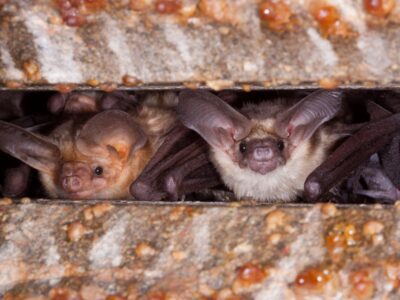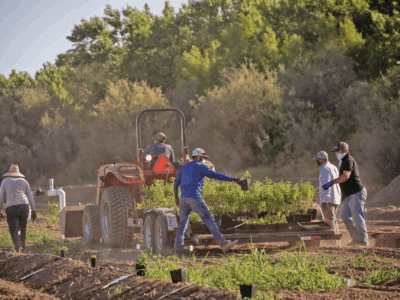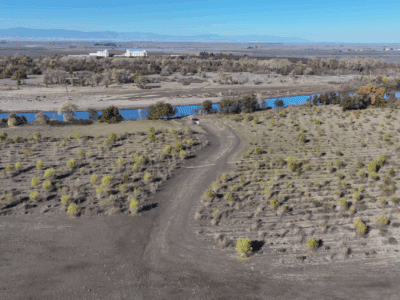After 10 years of management, four years of planning, and five active months of planting, River Partners will soon complete transformation of its 360-acre Hidden Valley Ranch, a former dairy west of Modesto, back into native wildlife habitat. But as we place the final tree along the final row in the final field, we have larger plans for the site and region.
Situated along the state’s second-largest waterway, the San Joaquin River, Hidden Valley Ranch is adjacent to River Partners’ historic Dos Rios Ranch, slated to become California’s newest State Park later this year. Eventually, Hidden Valley Ranch will provide the park-starved San Joaquin Valley with another recreation option, while also serving as a vital puzzle piece in one of the state’s largest contiguous corridors of floodplain habitat.
The state-funded project, located approximately 10 miles west of downtown Modesto, totaled about $20.8 million—$10.3 million to purchase the site and $10.5 million to restore it. Amongst the generous sources of funding are $6.3 million from the California Department of Water Resources (DWR) with the rest coming from the California Wildlife Conservation Board.
The project’s primary goal is to restore the former dairy farm, purchased by River Partners in 2014, into high-quality riparian habitat, while also replenishing freshwater on and off the property by transitioning commercial crops into low-water native plants and increasing groundwater recharge in the region. After three years of irrigating the new crop of native plants, River Partners will shut off the property’s pumps for good, freeing up even more water for the river, local ecosystem, wildlife like endangered salmon that call the river home, and ultimately the public.
Steve Rothert, Manager of the Division of Multi-Benefit Initiatives at DWR, notes how future floodplains at Hidden Valley Ranch could aid groundwater recharge, which is important to multiple groundwater-dependent ecosystems.
“Hidden Valley Ranch promotes California’s climate resilience by providing space for the increased flash-flood flows expected as the result of a changing climate, as well as providing more inundated floodplain and riparian areas to benefit special status species,” Rothert said. “And groundwater infiltration occurring during the wet season could also provide cooler flows back into the river during warm, dry summer months and improve water quality.”
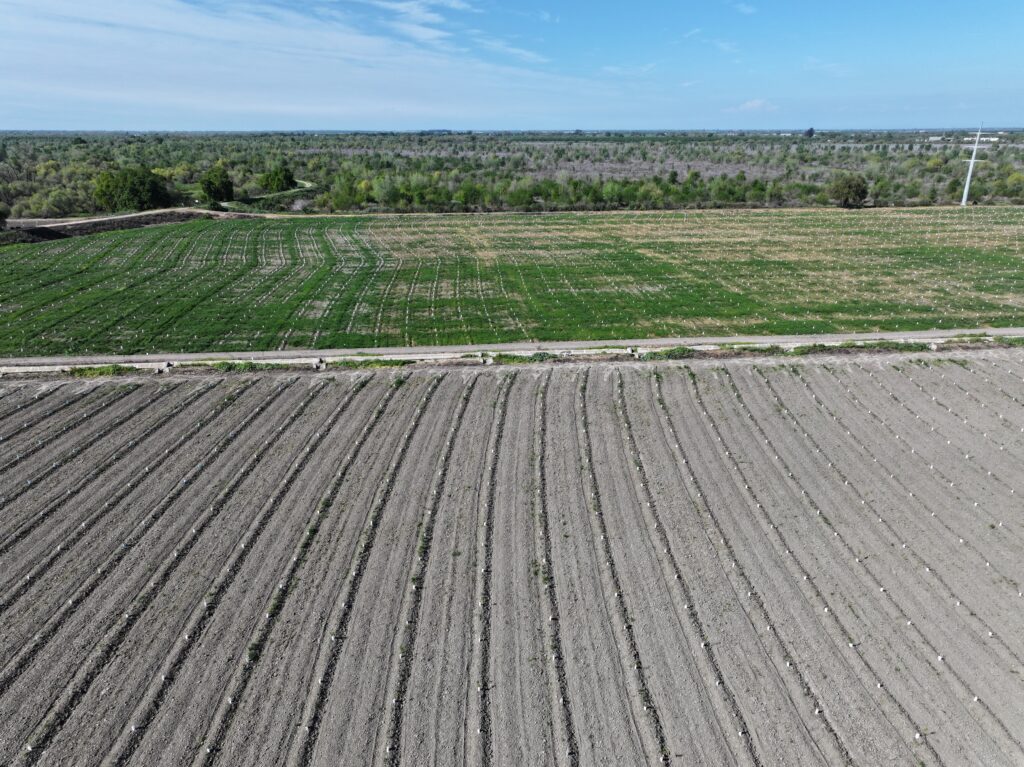
What was once part of a dynamic floodplain prior to European settlement, the area in and around Hidden Valley Ranch supported diverse riparian vegetation and wildlife. It boasted numerous, smaller flood channels with a range of plants, wildlife, and myriad river processes, like erosion, transporting sediment, and floodplain formation—all of which combine to shape a healthy landscape and influence ecosystems. Land-use conversion along the San Joaquin River in the 19th and 20th centuries replaced much of the area’s riparian vegetation with agriculture—eliminating processes that sustained native habitat recruitment and succession.
In total, River Partners planted over 75,000 native trees and plants. Fast-growing Fremont cottonwoods and willows provide an early upper-tree canopy for migratory birds and the early successional growth is preferred habitat for the endangered Least Bell’s vireo, while valley oaks are a keystone tree species and provide food and habitat to many endemic birds and invertebrates. Within a few years, these trees will grow up to 10 feet tall, towering over native shrubs we put into the ground, like elderberry (crucial habitat for the endangered valley elderberry longhorn beetle) and California blackberry, which offers habitat for the Riparian brush rabbit, which is nearly extinct.
The understory was planted with a mix of creeping wild rye (which provides food and habitat for the Riparian brush rabbit), gumplant (its long bloom period provides pollinator food and habitat for many local species), mugwort (which wildlife habitat and pollinator support), as well as a dozen other flowering and herbaceous species, to achieve a highly diverse understory that holds invasive weeds at bay.
Other spaces will abound with native grasslands, attracting sandhill cranes and other migratory waterfowl, like ducks and geese. Additionally, River Partners created three large dirt mounds to benefit the Riparian brush rabbit. Each bunny mound is nearly 50 feet high, ranges in size from roughly 1 to nearly 3.5 acres in size, and will provide ample food, safety, and shelter for the Riparian brush rabbits during floods.
The Riparian brush rabbit, native to the dense riparian forests along California’s Central Valley, currently only reside in one area in the entire world, the San Joaquin Valley. Since the mid-1800s, 95% of their habitat has been lost, fragmented, and redeveloped for cities and farming. With a mere 5% of their habitat remaining, the rabbits have very limited options for where they can relocate when floodwaters rise.
Over the last 20 years, River Partners has been intentional in its restoration of thousands of acres of habitat within the rabbit’s range, including at Hidden Valley Ranch at our neighboring Dos Rios Ranch Preserve.
More to Do
Though the restoration process is nearly complete, River Partners’ work is not done. Our teams will spend the next three years irrigating, monitoring, and maintaining the site to maximize the growth and health of our restoration. Top on the priority list is invasive plant management, which Wilson calls “pretty boring but extremely critical” to ensuring the health of the project.
“The No. 1 threat to any restoration project is invasive plants,” he said. “It’s not glamorous, but it’s hard work figuring out where these invasive plants are coming in, because they’re so good at displacing our native plants, and for our Operations team to remove them.”
River Partners will use more than a dozen acoustic recording units (ARUs) to monitor and track the sounds and movement of myriad wildlife that will buzz, tromp, and fly around the area, as well as seeing what our wildlife monitoring cameras have picked up. Our scientists will then analyze the data they collect to assess populations and monitor any changes in the field to inform future restoration efforts.
In the next year, River Partners hopes to receive approval from the U.S. Army Corps of Engineers to modify an existing levee adjacent to Hidden Valley Ranch that will reconnect the property to its natural floodplain and enable floodwaters from the nearby San Joaquin and Tuolumne rivers to inundate the ranch. Reconnecting the floodplain at the ranch will provide benefits like food and protection for struggling salmon as well as improved flood safety for downstream communities.
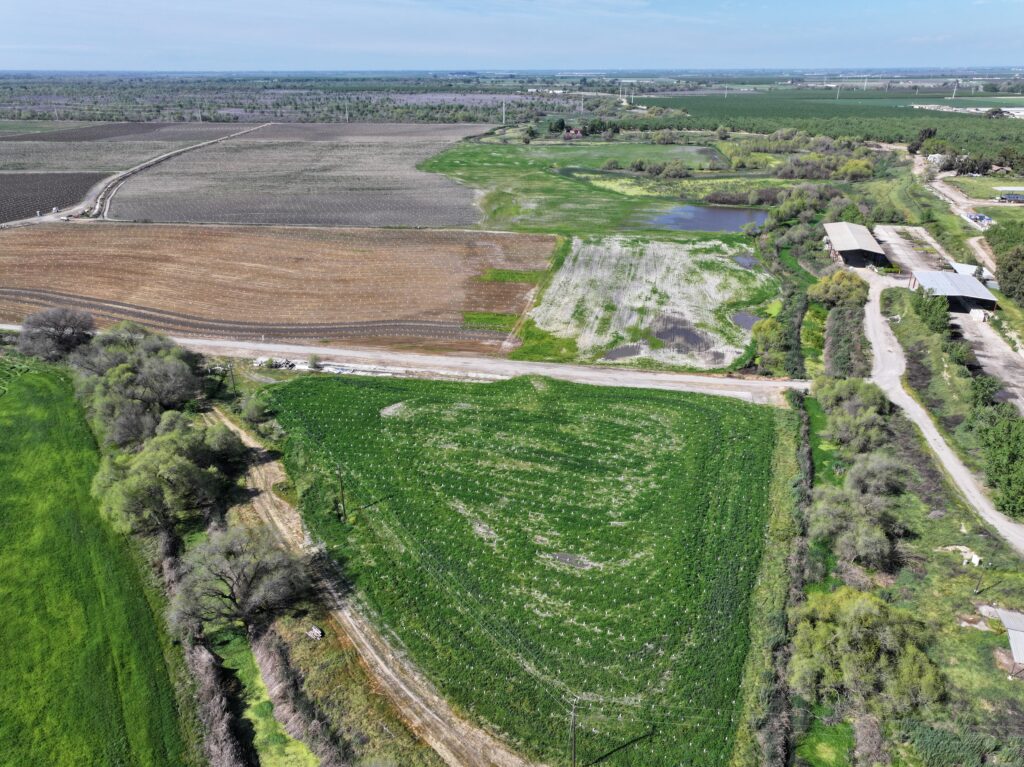
“It’s always been part of the original vision for Dos Rios Ranch, and once we complete Hidden Valley and the original vision to open this thing up, you’re talking about thousands and thousands of acre-feet of water that has room to strategically move out onto the expanded floodplain, which is a really meaningful amount for local flood planning,” said River Partners Senior Restoration Science Ecologist Neil Wilson. “Hidden Valley is a final piece of the puzzle that brings Dos Rios Ranch to its true potential.”
River Partners envisions handing over Hidden Valley Ranch to the state or federal agencies to manage in perpetuity for the benefit of healthy local ecosystems and communities.
River Partners’ San Joaquin Valley Field Manager, Austin Stevenot, a member of the Northern Sierra Miwok Tribe, isn’t only restoring a vital piece of the San Joaquin Valley’s riparian habitat puzzle. He’s also creating spaces for Indigenous people to practice their culture and to get people back and more in-tune with the landscape and understanding the history of cultural practices and identities.
And that’s more than creating space for wildlife to roam and floodwater to spread far and wide. It’s also planting native grasses, for example, so Tribal members can once again touch the plant, smell the soil, and feel what their ancestors had for millennia. Stevenot noted that families would tend to patches of certain native grasses as if they were tending to a garden. River Partners understands this importance and adds these culturally important touches to restoration when and where possible.
“It’s not just restoration of the floodplain, but it’s also bringing back the environment that was here for our people for millennia,” he said. “For me, it’s being able to give back to my cultural community I grew up in and being able to help our culture revive itself, to be able to create spaces to open up these places for people who want to learn our culture.”


